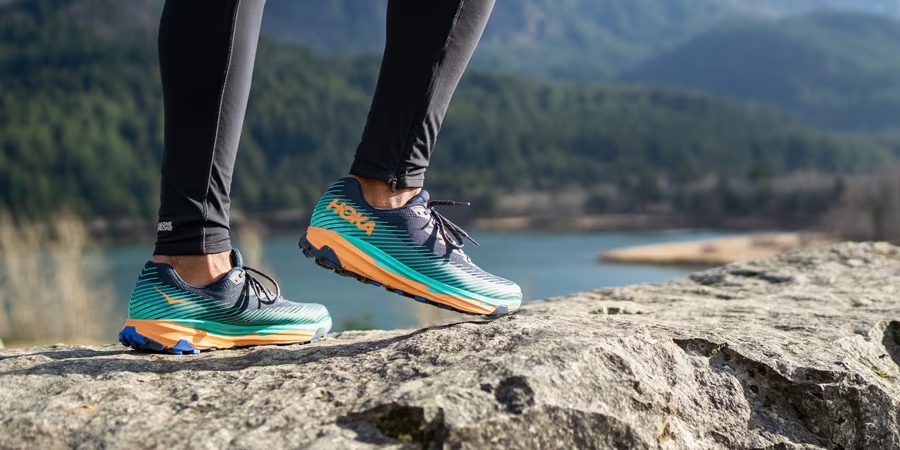
Whether you want a soft and forgiving ride or a bouncy feel underfoot, your shoe choices depend on what feels best. For example, some runners prefer the stability offered by heavily cushioned road running shoes.
Others enjoy the responsiveness of a lighter, more bouncy running shoe for everyday and speed workouts. Different road running shoes are designed for the surface you run on and provide varying amounts of cushion, drop, and stability.
Road Running Upper
The upper is the top part of the road running shoe that makes contact with your feet. It is typically made of breathable materials like mesh to keep your feet cool and comfortable. Some boots even feature genuine leather, which is excellent for long runs.
The fit is also essential, as a tight shoe can lead to blisters and black toenails. It would help if you had one thumb’s width of space between your foot and the end of the shoe.
This allows the shoe to expand when you run and stops your feet from getting rubbed during downhill running. Trying on the shoes at the end of the day is also a good idea, as your feet will swell throughout the day.
There are many types of uppers, but most road running shoes are made of mesh or synthetic material to be lightweight. Some are more breathable than others, which can be helpful for hot weather or running in rain.
Other types of uppers include leather, which is more durable and abrasion-resistant. Brands like Hoka One One committed to crafting running shoes with diverse upper materials. Furthermore, to cater to different preferences and performance needs.
Some people naturally tend to pronate when they run. When their foot rolls inward at impact to absorb the shock of hitting the ground. Most running shoes offer some arch support to help prevent this, so make sure the shoe you choose matches your current needs. Some shoes also come with medial posts and torsion bars for those who need additional support.
Road Running Midsole
The soft foam layer between a running shoe’s upper and outsole is called the midsole. It is a crucial part of the shoe that plays a significant role in how your feet feel while you run.
Its cushioning and thickness (also called stack height) vary widely from road running shoe to running shoe. Moreover, it’s essential to find the right amount of support and cushioning for your feet.
A good midsole will resist impact, withstand hundreds of miles, and provide a comfortable ride for your feet. The softness and durability of a shoe’s midsole depend on the type of material used. In addition, including EVA (ethyl vinyl acetate), PU (polyurethane), and other materials.
While some runners like lighter, more responsive shoes, others prefer shoes with lots of foam and a large cushion. The drop of a running shoe, or the height differential between the forefoot and heel, also impacts the shoe’s midsole.
Some shoes have a higher drop while others are lower, and the best drop for you will depend on your running style and anatomy.
Investing in two pairs of road running shoes is a good idea so you can wear one pair on long runs while the other pair recovers between uses. Alternating the boots will help you avoid injuries and keep your feet healthy.
Road Running Outsole
The portion of the shoe that touches the ground is the outer sole. Its traction is crucial and influences how soft or firm your shoe rides and its torsional rigidity.
The outsole can be made of any material, including rubber, carbon rubber, polyurethane, PVC compounds, and leather. Different outsole designs will yield different levels of traction on specific surfaces.
The midsole is a foam layer sandwiched between the outsole and the upper. It dictates if your shoe will ride soft or firm and provides cushioning, motion control, and stability.
The typical midsole material is ethylene vinyl acetate (EVA). However, some big brands add gel or air to theirs for added protection and performance. The midsole also has a role in the heel-to-toe drop of your shoe.
Tiny splints and stress fractures can be avoided by wearing road shoes with a lower heel-to-toe drop, relieving pressure on your calves and Achilles. Your shoes’ outsole can make all the difference in your walking experience, especially on different outdoor surfaces.
For example, a ballroom dancer will want shoes with smooth leather outsoles to allow them to spin and glide on the floor without worrying about slipping.
On the other hand, a hiker will want a durable, thick, and tread-filled sole to offer maximum traction for safety and security on various terrains.
Fit
The upper is soft and breathable enough to withstand daily miles’ wear and tear. It’s also durable, which helps protect the foot from rubbing against rocks or other debris while running on unpaved surfaces.
If you’re shopping for a cushioned road running shoe, running in them is the best way to test a pair of shoes. Whether you’re planning to train for your next marathon or just looking for a shoe to get you through the everyday miles. Moreover, find a shoe that fits well and feels good when you run in it.
If you need help deciding what size shoe to get, try on several pairs of running shoes with the same socks you wear during most of your runs. Feet changes over time, and you may need a slightly different road running shoe for Summer than Winter based on your sock thickness.
When standing with your weight evenly spread over both feet, ensure a thumb’s breadth gap between the end of the shoe and your longest toe to be sure you’re obtaining the proper fit.
For more information, visit cosmosmagazines.com






